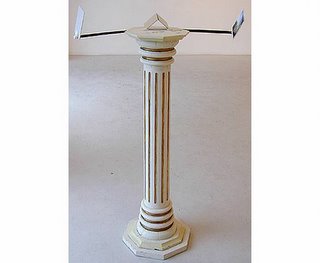 AN INTERVIEW WITH IDA SELBING
AN INTERVIEW WITH IDA SELBINGAt the age of 26 she earns her masters degree at the prestigious Royal Academy of Fine Arts in Stockholm. She called her latest piece
La Grande Finale. But there’s nothing pretentious about
Ida Selbing and her art. She belongs to a tradition of artists carefully examining the boundaries of human knowledge - and human life.
- To me, working with art is a way to understand the world. In a strict sense you shouldn’t have to produce things to understand your surroundings, and I’m not always sure that the work I produce surprises me or teaches me anything I didn’t already knew. But in any case, the process leading up to the finished product is a way for me to learn, and to find something out. You could do that using other means, but I guess that I think better – or rather? – through art.
I first found out about Ida Selbing an art fair in Stockholm about a year ago. She exhibited a mesmerizing installation named
Centripetal. In her own introductory text to the piece she explains:
"If you move in one direction towards a point that is infinitely distant, or in an undefined position, you practically stand still. Any advancement is undetectable. Are you getting closer to the point when you are moving towards it? Is it possible to define something through slow encirclement?"
Is the answer to that question is yes or no? Are you describing a failed attempt to gather knowledge about the world, or the only possible way to act? Is your art in itself is "slow encirclement"?
- I personally believe that the answer is yes, but the piece in itself doesn’t give an answer. I think that, in a way, it’s the only possible way to act. I think that you do get closer to something when you are searching for answers, but you probably never hit the spot right on, even when you think you do, or when you try the best you can.
Ida Selbing doesn’t mass produce her art. She takes the time needed to follow through. Her pieces are thorough in concept as well as in execution. I would probably characterise her work as dealing with issues of knowledge and perception – a direction of art becoming increasingly popular among young Scandinavian artists. But, she doesn’t agree fully with this description when asked about it.
- I’m not sure I belong to the artists dealing with those kinds of questions. Rather, I think I deal with the consequences of these questions.
She is obviously in depth to the conceptual and minimalist traditions of the 1960s. She says that these days she has stopped having idols but mentions
Richard Serra and
Eva Hesse as earlier sources of inspiration. Her latest work was labelled "Sol LeWitt goes disco" in one commentary.
How important is mathematics to you? Is it a means to an end, or a purpose in itself?- It’s neither a purpose nor a means to and end to me. Mathematics is interesting as a way to think, and I often feel that I somehow use the same part of my brain when I’m working with my art as when I’m doing maths. It’s been a while since I worked with "pure" mathematics, but I sometimes think that the reasons I once had for starting to study to become a mathematician are related to the reasons I have for being an artist.
What is the value of aesthetics? Most of your work is very pleasing to the eye. Is this important to you?- Aesthetics in itself holds no real value, it is rather a means of communication. Aesthetics is part of our language. But it can be difficult when it gets in the way of the message. But I don’t want to force it out of the picture just because. I don’t think I can change how I work. Surface, if that’s what you mean by aesthetics, is nothing I have a problem with.
Scandinavian art is moving in several directions at the same time. In Finland a new wave of expressionism is coming on strong. Many young artists from Norway and Sweden, especially male, are working with strong ties to modern popular culture.
In a way, Ida Selbing is a good representative of the cooler, analytical approach preferred by many of the students leaving the Royal Academy of Fine Arts in Stockholm these days. What makes her stand out from the crowd, in my opinion, is the sharpness of her analysis. She doesn’t settle for the easier problems, but goes straight for the ontological core.
None the less, being a political creature by birth and choice, I have to ask her if she, and her fellow colleagues, doesn’t stand the risk of coming off to careful, to post modern? If she doesn’t think that there are more important issues to deal with in the world today?
- There is nothing wrong with being post modern as such, now, is there? For my own part, I believe that I deal with important issues. Sometimes I get to the issues in a roundabout way, but I am very focused on specifically the things I consider important. I don’t think I am extra careful in coming to conclusions, but I’m probably ambiguous, unclear and dubious. This is a rather normal approach for many artists and not very radical, but the way I see it it’s much more dangerous to be to obvious, or single minded if you will. If you try to be as open or "true" as possible, it’s hard to be clear and consistent.
























